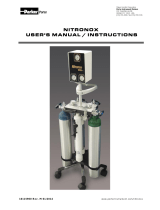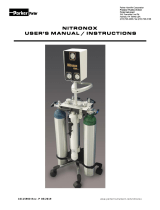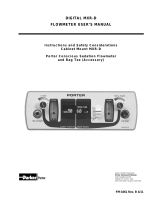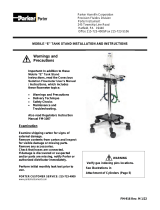Page is loading ...

FM-1330 Rev C 05/2019 www.porterinstrument.com/medical
M E D ICA L B R E A T HI N G C I R C U I T
S C AV E N G E R S Y S T E M
U S E R ’ S M A N U A L / I N S TRU C T I O N S
Examination
All components should be removed from their respective shipping containers and examined. Any
omissions and/or damage should be reported to your Porter dealer immediately.
User Responsibility
The Medical Breathing Circuit Scavenger System (with Porter disposable Medical Breathing Circuit) is
designed for use with Nitronox® HD Inhalation Analgesia System (Refer to Instructions FM-1308), or an
Analgesia Conscious Sedation Flowmeter (Refer to Analgesia Conscious Sedation Device Instructions)
to perform in accordance with specifications herein when installed, operated and maintained as instructed
in this manual. It should be carefully read and understood prior to operation and use of the scavenger
system.
Warnings (administration of N2O/O2 conscious sedation analgesia)
The Scavenger System is intended to be used by medical personnel trained in its use and the use of
nitrous oxide and oxygen for medical applications.
An EXPLOSION hazard exists when flammable agents are exhausted into the vacuum system
(Page 5).
The Scavenger Interface is supplied with a removable foam flow resistor. This foam resistor must be
REPLACED every six months to help prevent the possibility of increased resistance due to particle
entrapment (Page 8).
Use Scavenging: Medical workers are exposed to N2O during administration of N2O/O2 conscious
sedation analgesia. Controls are effective in the patient treatment area to achieve low levels of ppm
(parts per million) exposure. Controls include System Maintenance, Ventilation and Work Practices.
Your accessory Scavenger System is an important part of the system of controls in medical settings.
Warning: When using a single use full face mask or mouthpiece dispose of mask after use to prevent
patient cross-contamination. When using sterilizable mask, follow manufacturer’s sterilization
instructions.
Warning: Use patient observation to prevent over sedation. If a patient becomes over sedated when
being delivered 100% oxygen [during an apparent loss of nitrous oxide supply], it is a definite indication
of crossed lines. If crossed lines are suspected, remove the mask immediately and encourage mouth
breathing. Deliver pure oxygen only if the oxygen source is independent from the suspected crossed
lines area.

2
Medical Breathing Circuit Scavenger System - Description
The Medical Breathing Circuit Scavenger System is an Interface for the removal of patient exhaled O2 /
N2O gas mixtures generated from the Nitronox Inhalation Analgesia System or the Conscious Sedation
Flowmeter System and Medical Breathing Circuit. The exhaled gases are routed through the Interface
to a vacuum system. The Scavenger and vacuum systems provide dilution and disposal of mixed waste
gases. The Scavenger System consists of components necessary to transfer patient exhaled gas
mixtures to the source of vacuum.
Ambient opening
(foam resistor)
Scavenger Interface
Drain Valve
The system components are:
A Scavenger Interface (Fig. 1.1) to connect the vacuum system with the Scavenger System. It
contains:
o Orifices to limit vacuum pressure and flow.
o Opening to ambient to help prevent over/under pressurization from patient exhaust.
o A valve to automatically drain any internal condensation.
A Nitronox Demand Valve Mount (Fig. 1.2) to seal the exhaust ports of the Demand [breathing]
Valve, or
A Flowmeter with Bag Tee (Fig. 1.3) to deliver the Conscious Sedation mixture to the Medical
Breathing Circuit (using Breathing Circuit “tee.”).
A corrugated magenta 19mm hose (Fig. 1.4) with one way valve to connect the Medical Breathing
Circuit to the Interface. The hose is an integral part of the disposable Medical Breathing Circuit.
The Interface is typically connected to the center post on a Mobile Cart or Wall (see FM-916 for
E-Stand and FM-1346 for 2-Cylinder Mobile Cart). For Sentry Sedate see FM-1274 (see Fig. 1.5,
Fig. 1.6; Note: A Porter Bag Tee attaches to the Gas Output Bulkhead prior to attachment of the
Medical Breathing Circuit.).
Fig. 1
Fig. 1.1
Interface
Fig. 1.4
19mm Hose
Fig. 1.2 Nitronox
Fig. 1.3 Porter MXR
Fig. 1.5 Sentry Sedate
Fig. 1.6 Gas Output
Sentry Sedate

3
Medical Breathing Circuit Scavenger System - Description
The gas flow path through the Scavenger System starts with patient exhalation from the mask into the
coaxial tubing of the disposable Medical Breathing Circuit and then to the tee of the Medical Breathing
Circuit through the one-way valve into the 19 mm scavenger hose. The flow path is one-way
directional and reinforced with a one-way valve. The hose leads the gas into the Scavenger Interface.
The Interface is open at the top to ambient via a foam resistor. In addition, the Interface contains an
internal pathway for gas passage permitting waste gas to follow a preferential path to vacuum.
From the internal pathway of the Interface, the waste gas flows through a ball-type control valve to a
calibrated orifice contained within the barbed vacuum connector. The final gas path is through the
vacuum hose to the vacuum outlet.
If vacuum flow through the calibrated orifice exceeds the exhaled flow from the patient, room air will
be drawn from ambient into the vacuum system via the Scavenger Interface. Also the internal volume
of the Interface acts as a surge chamber to absorb a short duration of excessive patient exhalation
flow. During this short duration, excess gas will fill the Interface allowing time for the vacuum flow to
exhaust the gas during the next patient inspiration. Control of scavenging vacuum flow to the vacuum
source through the orifice is provided by the ball control valve. The ball valve adjusts the scavenging
vacuum flow between an upper (maximum) and a lower (minimum) limit. Higher vacuum flows assist
in scavenging higher levels of patient exhalation flow.
An automatic relief valve is provided in the bottom of the Interface to prevent condensation from
causing a water seal of any internal gas passages. This is feature operates only when condensation
occurs.

Installation Options
Mobile Stand Mount
Connect the cylindrical Scavenger Interface to the center column assembly of the Mobile Stand (Figs.
2.1, 2.2). Use the mounting clips of the Interface to position the assembly on the column. Orient the
Interface assembly vertically with open end (foam resistor) up and condensation relief drain valve
down.
Wall Mount: Fig. 3
1. Hold the Scavenger Interface against the wall in the desired mounting location. The 19 mm
magenta corrugated hose is 2 ft. long (61 cm) and must connect to the Analgesia Conscious
Sedation Device output and the Scavenger Interface.
2. Mark four mounting-hole locations on wall using the Interface mounting plates as templates.
3. Drill four holes in the locations marked:
Note:
For dry wall or plaster, use a suitable screw attachment method to secure against pushing
and pulling of hose connections.
For wooden studs, drill appropriate pilot hole, 1-1/2 inches (4 cm) deep to accept mounting
screws.
4. Insert appropriate receptacle (not provided) in hole, if necessary.
5. Mount the Scavenger Interface using four screws (not provided) in the prepared locations (Fig. 3).
Note: Mounting installation must be done on both the top and the bottom brackets.
Fig. 3 Scavenger Wall Mount
4
Fig. 2.2
Fig. 2.1

Scavenger Interface Mounted on Sentry Sedate
1. If holes are not pre-drilled, use LB-730 Plastic Template to align with Front Cover and mark hole
locations and drill appropriate pilot holes or use the self-tapping feature of the included mounting
screws (See Fig. 3.1).
2. The Scavenger Interface mounts on the Front Cover of the Sentry Sedate using 4 screws through
mounting plates and 4 holes in Front Cover (See Fig. 3.2)
3. Protective caps for the screw ends inside the cover are provided (See Fig. 3.3
Hose Connections: Fig. 4
1. Connect the 19 mm magenta corrugated scavenger hose of the disposable Medical Breathing
Circuit to the Interface (Fig. 4.1).
2. Connect vacuum hose between the vacuum source inlet (using appropriate connection such as
DISS, QUICK Connect, etc.) and the barbed outlet connector on the Interface. Push the tubing on
the barb so that two to three barbs are covered.
Note: Hold the barbed outlet while pushing tubing onto barb to reduce excess strain.
19mm Hose Connection Warning (remove cap)
Barbed Outlet
Connection
(remove cap)
Fig. 4
Fig. 4.1
5
An explosion hazard exists when
flammable agents are exhausted
into the central vacuum system.1
On front cover
Fig. 3.2
Screws inside cover (place caps)
Fig. 3.3
Use of template / kit
Fig. 3.1

Operation
1. Connect Wall, Mobile E-Stand, or Sentry Sedate gas supplies [O2 and N2O] to Nitronox or
Flowmeter. Connect vacuum source to Scavenger Interface barb.
2. Ensure Interface black lever valve is in the on [open] position before beginning procedure. For
best scavenging vacuum flow, turn the ball valve lever to the vertical (full on position; 6 o’clock)
(Fig. 5).
Note: With the ball valve lever in the full on position, the vacuum flow should accommodate
the exhaust gas from all normal breathing patterns (30 – 35 LPM, maximum).
3. If the overall demand for vacuum is overloading the central system, the ball valve may be slightly
throttled to reduce vacuum flow by turning the ball lever to the 7 to 8 o’clock position.
Note: With the lever in the mid 7 to 8 o’clock position, the ball valve will still allow a vacuum
flow of 8 to 12 LPM, minimum. Minimal flow position is 9 o’clock.
4. Removal of ball valve lever to “lock-in” adjustment position: Remove holding screw and ball
valve lever after adjustment to full on position [eliminates inadvertent lever position change]. To
place lever back again for adjustment capability, take care to slide into full on, 6 o’clock position
and assure lever range is from 6 o’clock to 9 o’clock.
5. The Interface is designed so that condensed water vapor should discharge from the bottom, if its
volume exceeds 40 to 50 cc/mL.
6. Read and follow the directions in the Instructions FM-1329: Using the Porter Medical Breathing
Circuit with Nitronox (Demand Flow) or with Analgesia Conscious Sedation (Continuous Flow)
Devices. Maintenance
Cleaning
We recommend the use of an approved disinfectant or surface wipe for the dental / medical
environment for cleaning the outside of the Scavenger System. Do not spray disinfectant directly
onto housing. Spray disinfectant into disposable towel and wipe unit thoroughly removing excess
disinfectant to eliminate buildup.
CAUTION: Introduction of moisture or other contaminants into this device may result in defective
operation.
CAUTION: Never oil or grease any part of this system (minimize fire or explosion potential).
Field Replacement Foam Resistor
1. Replacement of the foam flow resistor PN 61962300 (refer to Figure 1.1) approximately every six
months.
Warning
The foam flow resistor is to be replaced approximately every 6 months to help prevent the
possibility of increased resistance due to particle entrapment.
2. Pull the foam resistor (one inch, diameter, by six inches, long) from the top center hole of the
Interface cylinder with the use of forceps or needle nose pliers.
3. Insert a new foam resistor into the Interface top-center hole until the top of the foam resistor
reaches the lower edge of the horizontal vent holes.
Replacement Parts: Contact Porter or your authorized Porter Dealer
Fig. 5
6

Development of Delivery Protocols
It is the responsibility of the medical establishment and the medical professional to develop and
establish specific delivery protocols.
The Nitronox Inhalation Analgesia System is designed to deliver a fixed concentration of 50% nitrous
oxide and 50% oxygen on the demand flow [self-administration] principle. The Conscious Sedation
Flowmeter with Bag Tee is designed to deliver a variable concentration of nitrous oxide and oxygen
on the continuous flow principle. The medical professional will turn on and observe the operating
indicators of the device. In order to receive the analgesic, the patient may assist [Nitronox: will self-
administer] by holding the face mask firmly in place during the procedure. With the face mask sealed
every time the patient takes a breath, the patient will receive the full effect of the mixed gas through
the face mask [Nitronox: the patient inhalation will open the demand valve].
Common procedures conducted with Nitrous Oxide – Oxygen Analgesia Conscious Sedation.
Ideal for minimally invasive procedures where there is a desire for pain management to reduce anxiety
or to deliver minimal sedation.
The Nitronox Inhalation Analgesia System and the Conscious Sedation Flowmeter delivery is
considered transient (less than 60 minutes) in terms of continuous use when providing Analgesia (pain
management), or Minimal Sedation. However, a procedure or medical condition that occurs over the
course of many hours, also is considered to be using transient delivery, in that, given administration
techniques, the patient will be unlikely to hold the face mask to the face continuously for over 60
minutes. For example, a woman in labor may safely use conscious sedation (typically using a Porter
Demand Flow Nitronox device) in a transient self-administration mode over the course of several hours
as secondary labor and end labor stages are experienced. The upper limit of the number of hours of
this described transient delivery is at the determination of the medical professional.
Patient Population (Adult and Pediatric): Used to deliver a gas mixture to a conscious
spontaneously breathing patient who is awake, alert and cooperative and requires relief from
minimal to moderate pain and is under the continuous supervision of a healthcare professional.
Age/Weight limitations: see Relative Contraindications (at the determination of medical
professional).
Note: Porter recommends the use of a disposable full face mask (DEHP-free and Latex-free) that is
biocompatible for medical use. Follow manufacturer’s instructions. The disposable mask materials
have been chosen by the medical device manufacturers of the masks intended for medical usage.
Many establishment protocols also call for the use of a bacterial filter. Follow manufacturer’s
instructions.
7

Continuous Flow vs. Demand Flow Devices
Equipment to deliver nitrous oxide and oxygen analgesia conscious sedation are often
categorized as demand flow or continuous flow devices. The Conscious Sedation Flowmeter
is a continuous flow device, while the Porter Nitronox is a demand flow device. Specific delivery
protocols will be established for the two categories of equipment. The differences center
around self-administration for demand flow devices vs. direct administration by medical
professionals for continuous flow devices. Also, continuous flow devices typically allow the
administration of variable concentrations of nitrous oxide and variable flow rates of delivered
mixture. However, some establishments have developed specific protocols for delivery with
continuous flow devices, where the medical professional is able to adjust to deliver various
percentage mixes, where, with supervision, the delivery could be described as “self-
administration,” in that the patient will hold the full face mask to the face. Do not use a strap
with the full face mask.
*Basic Delivery Technique [for Continuous Flow Applications with variable percentage
delivery]:
“Practice titration. Titration is a method of administering a substance by adding definitive amounts of
a drug until an endpoint is reached. For nitrous oxide / oxygen (N2O) / O2) sedation, N2O is given in
incremental doses until a patient has reached a comfortable relaxed state of sedation. The ability to
titrate N2O is a significant advantage because it limits the amount of drug to that which is required by
the patient. If titration is done properly, the patient does not receive any more of the drug than is
necessary. The amount of N2O required by a patient on any given day or time varies.”1
For information on titration, a most valuable resource for the practitioner is the Handbook of Nitrous
Oxide and Oxygen Sedation1, written by Clark and Brunswick and published by Mosby
(www.mosby.com). This text is a concise and contemporary guide for nitrous oxide / oxygen
administration.
SIDE EFFECTS & CONTRAINDICATIONS
The medical professional should establish proper evaluation of Side Effects &
Contraindications for the individual applications.
8

Scavenger System Specifications
Note: Porter may apply technical advances whenever it is desirable. Specifications are subject to
change WITHOUT NOTICE. Porter should be contacted for current information.
Materials of Construction - Plastics: ABS, PVC, Polyethylene, Nylon
Dimensions:
Diameter Length
Scavenger Interface 2-1/2” (6.4 cm) 20” (50.8 cm)
Scavenger Hose (19 mm) 19 mm, ID 24” (61 cm)
Vacuum Hose 3/8” (9.5 mm), ID As Required
Vacuum Source:
Pressure -10” to -21” Hg (-250 mm to -533 mm Hg)
Interface Flow:
Ball Valve Full Vertical Ball Valve 45º Position
(Max. Flow) 30 – 35 LPM (Min. Flow) 8 – 12 LPM
Relief Valve (Condensation):
Relief Volume 40 – 50 cc/mL
Retention Volume 5 – 10 cc/mL
Ambient Temperature Limits:
Minimum 40ºF (5ºC) Maximum 140ºF (60ºC)
9

CERTIFICATE OF WARRANTY
THIS WARRANTY IS GIVEN IN PLACE OF ALL OTHER WARRANTIES, EXPRESS OR
IMPLIED, OF MERCHANTABILITY, FITNESS FOR A PARTICULAR PURPOSE OR
OTHERWISE.
Under no circumstances shall Parker Hannifin Corporation be liable for incidental or consequential damages as
those terms are defined in the uniform commercial code.
Parker Hannifin Corporation, Porter Instrument warrants that each product or part shall be free from defects in
workmanship and materials, under normal use and with appropriate maintenance, for one (1) year from the date
of delivery to customer unless otherwise specified in writing. All rubber and plastic parts and accessories are
warranted under the same conditions for a period of ninety (90) days from date of purchase.
No statement or claim about the product by any employee, agent, representative, or dealer of Parker Hannifin
Corporation shall constitute a warranty by Parker Hannifin Corporation or give to rise to any liability or obligation
of Parker Hannifin Corporation.
Parker Hannifin Corporation shall not be liable for any damage, injury or loss arising out of the use of the product,
whether as a result of a defect in the product or otherwise, if, prior to such damage, injury or loss, the product
was (1) damaged or misused; (2) repaired, altered or modified by persons other than Parker Hannifin
Corporation; (3) not installed in strict compliance with applicable codes and ordinances; or (4) not installed by
an authorized Parker Hannifin Corporation dealer. Parker Hannifin Corporation's obligation for breach of this
warranty, or for negligence or otherwise, shall be strictly and exclusively limited to the repair or replacement of
the product or part. This warranty shall be void on any product on which the serial number has been altered,
defaced or removed.
ORDERS All orders are to be made through authorized Parker Hannifin Corporation distributors. All billing will
be done through said distributors. Direct orders will be handled through the authorized local dealer as
determined by Parker Hannifin Corporation.
RETURNS All returned merchandise will be handled through the local Parker Hannifin Corporation distributor.
No returns will be accepted unless authorized in writing by Parker Hannifin Corporation and accompanied by the
original shipping invoice. All returns are subject to restocking charge.
Policies subject to change without notice.
The Quality System for Porter Instrument is certified to ISO 13485.
Visit our website: www.porterinstrument.com for additional information.
To download a User’s Manual: www.porterinstrument.com/resources-dental choose Manuals tab
/









